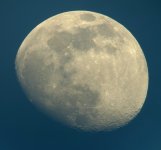paperweight
Well-known member
Had a chance to take a picture of Crescent Moon in the blue sky shortly before dusk and loved the contrast of the blue sky and the moon. So far, I'm happy with my 99a and will do more star tests as soon as circumstances allow for it. Tonight the moon is too dominant in the sky.
I think the move from my Gitzo Reporter to the Berlebach Uni 16c and the Pegasus head has really added a lot of stability. Camera is a Sony RX 100 II on a Kowa DA4/DA10 digiscoping adapter. Image data: ISO 100; 1/80sec; Aperture 7,1; Camera Zoom 1,3

I think the move from my Gitzo Reporter to the Berlebach Uni 16c and the Pegasus head has really added a lot of stability. Camera is a Sony RX 100 II on a Kowa DA4/DA10 digiscoping adapter. Image data: ISO 100; 1/80sec; Aperture 7,1; Camera Zoom 1,3




